As many of you know, even though we have been closed for the past 11+ weeks, work has not stopped at Cheyenne Mountain Zoo. Through our social media channels, we have shown you lots of sneak peeks at what our keepers and animals have been up to, but Bob Chastain, president and CEO of #CMZoo, has also been busy. Among the many partnerships formed during this critical time, some of those formed out of working through our variance request to reopen the Zoo have been the most important. Huge thanks go out to the Colorado Springs Mayor’s Office, including Mayor John Suthers and City Manager Jeff Greene, El Paso County Public Health and officials at all three area hospitals, and the El Paso County Commissioners. We are still waiting for the final step for reopening, but Bob’s here to tell you a little bit more about the process, introduce you to some excited and friendly warthogs, and talk about what reopening will look like, especially for our members. #ClosedButStillCaring #AbnormallyNormalatCMZoo
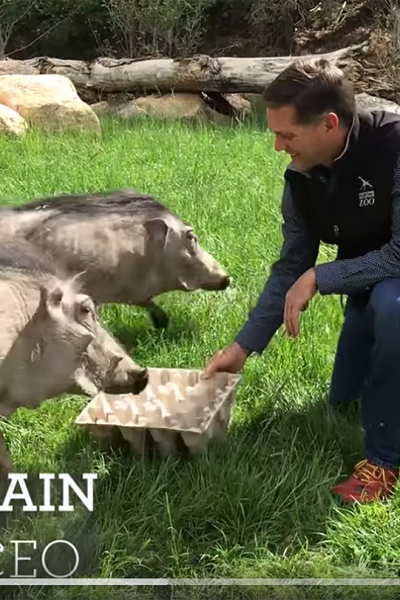

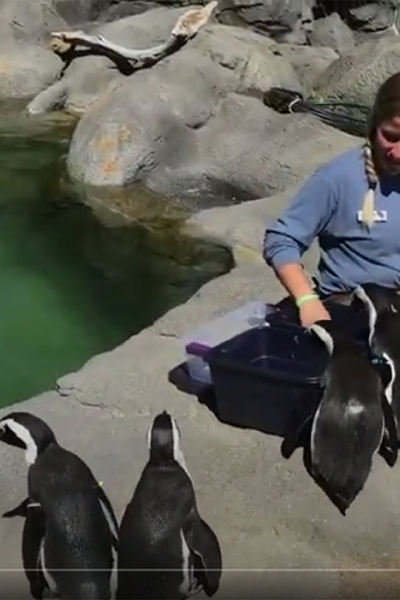

Join us for breakfast on the beach of Water’s Edge: Africa. Animal keeper, Al, is feeding our flock of 11 African penguins while she tells us about their personalities – and how you can identify each penguin.
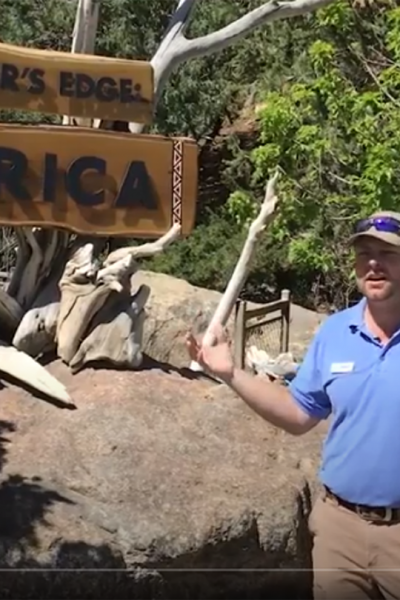

Meet some of the keepers, see some of the animals and learn about some of the cool features of our newest exhibit for hippos and penguins – Water’s Edge: Africa!
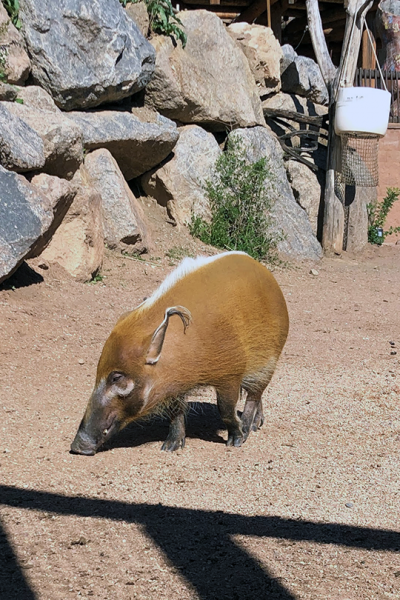

A new African Rift Valley resident is making progress with her keepers and is taking her time getting to know her potential mate. Six-year-old Red River hog, Zena, came to Cheyenne Mountain Zoo on a breeding recommendation with 12-year-old Hubert, who has lived at CMZoo since 2008.

Zena, who can be identified by her unique white ear tassels, has a shy and hesitant personality, but has already formed a trusting relationship with her keepers, who say she’s an excellent student.
“She already participates in her own health care with voluntary injection training, crate training and shift training,” said Philip Waugh, an African Rift Valley animal keeper who works closely with the Red River hogs. “She has the cutest hooves, and she runs really fast. She almost looks like a ballerina on her tip toes. It may seem like a strange thing to say about a hog, but she’s beautiful. Her eyes are really expressive.”
Because of Zena’s timid demeanor, her keepers are allowing lots of time for her to gain confidence with Hubert – known as ‘Huey’ by his many fans – who was selected by the Red River Hog Species Survival Plan as a good breeding partner for Zena based on their genetics. Since her arrival, the two have maintained interest in each other, but their comfort levels while sharing space have fluctuated.
Zena and Huey first got acquainted through a mesh barrier, which allows them to smell, hear and see each another without sharing the same space. Introductions with a protective barrier – known as ‘howdies’ – allow keepers to observe the hogs’ behavior towards each other and indicate whether the hogs are ready to take things to the next level.
“During howdies, the two of them smell each other, lie on either side of the mesh and even touch noses through the mesh,” said Waugh. “All of those calm behaviors usually indicate they’re ready for the next step in their introduction.”
Once the two are sharing a space, however, Zena hasn’t been as confident.
“This has been an interesting introduction because they are definitely interested in each other and even show us that they’re more comfortable when the other one is nearby,” said Waugh. “We’re just not quite seeing that comfort carry over when they’re sharing a space without a barrier between them yet.”
One sign of comfort during howdies is Zena pushing her body up against the mesh and Huey calmly smelling her from the other side. Another is a call they make to each other when they’re visually and physically separated. Zena is also generally calmer in a space by herself when Huey is in the space next door.
“When they’re in spaces within earshot of each other, but can’t see each other, we’ve noticed they will make little calls back and forth,” said Waugh. “That’s a good sign because it means even though they’re not quite ready to spend time together physically, they are acting as a social unit.”
The two hogs are making progress, but these things sometimes take longer than anticipated.
“They’re both such sweet-natured hogs and we’re seeing progress, so we’re going to keep trying,” said Waugh. “Huey has lived with Ari for so long and Zena spent a lot of time by herself previously, so this is like a first-first date for both of them. We all know how awkward first dates can be, so we’re working to make their time together as positive as possible, so they can recognize it’s safe and beneficial to be together.”
When keepers manage introductions between animals, they listen to what the animals are telling them through their body language and behaviors. If an animal appears uncomfortable with the scenario, their team makes changes to help the animals recognize that they have control in their environment. Placing different kinds of enrichment in the introduction spaces and changing introduction spaces can be beneficial.
Keepers have tried introducing Zena and Huey without a barrier only twice. The most recent space, which has shown promise, is in the zebra and okapi yards, which share a fence and can be adjoined. Most mornings, CMZoo giraffe cam fans have watched in delight as the two hogs run separately through the giraffe yard to spend time outside in the adjacent spaces.
“Animals all have different personalities, and Zena is on the timid side, so we’re giving her plenty of time to gain confidence around Huey,” said Waugh. “Although they haven’t been perfect, their introductions have been safe, so we’ll continue following their lead and trying new things that might give her more confidence. Maybe this new space will be just what they need – and hopefully the third time is a charm!”
The ultimate goal is for guests to get to know Zena on exhibit with Huey. 18-year-old female Red River hog, Ari, will also share on-exhibit time with Huey, and have the yard to herself sometimes. Ari, who birthed four healthy piglets over the years with Huey, is no longer recommended for breeding, but will continue being a stellar animal ambassador at CMZoo for the foreseeable future.
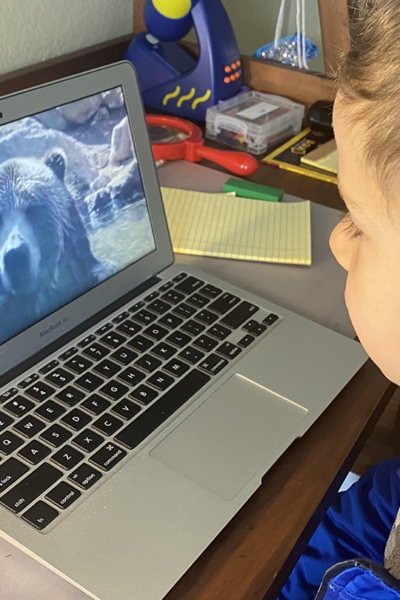

Like most businesses, the Zoo has adapted to these unprecedented times and is committed to our mission of connecting people with animals. The Zoo may be closed, but that doesn’t mean you can’t see the animals or virtually visit our grounds! Cheyenne Mountain Zoo has launched four different virtual programs keep you connected and offer fun ways to support the Zoo during these difficult times.

Custom Animal Shout-Outs: Shout outs are 4- to 5-minute pre-recorded videos that feature an animal ambassador of your choice, customized to include a unique message for someone special. Birthdays are currently the most popular, but graduation celebrations, anniversaries, or “just because” messages can also be featured. It’s a fun and unique way to support the Zoo and remind someone in your life that you are thinking of them, and bring a smile to their face.
Animal Interviews: This option features up to 30 minutes via a live virtual connection with an animal ambassador of your choice from The Loft and a keeper to share fun facts, demonstrate some great behaviors, and answer any questions you might have about the animal. This is perfect for a curious child who loves animals, a classroom learning about a certain species, or even a group of adults who might miss seeing some animal friends at the Zoo. Really, anyone can enjoy an animal interview!
Virtual Custom Curriculum: Curriculum videos feature up to a 30-minute pre-recorded tour of the Zoo. A CMZoo educator will walk you through the Zoo and create content based on your request. Animal lifecycles? No problem! Focus on Colorado species? Done! Weird and wild facts? Let’s do this! Just miss seeing the Zoo and want to do a 30-minute loop? We are here for you! Because the content is customizable, tours can be created for just about anyone or any group of animal lovers.
Virtual Animal Encounters: These 20-minute virtual live encounters are similar to Animal Interviews, but include opportunities to virtually visit with animals from all around the Zoo! Enjoy a private 20-minute virtual session with your choice of sloths, elephants, meerkats, zebras and more.
You can still visit your favorite Zoo and your favorite animals, while keeping a safe distance! Visit cmzoo.org/virtual to learn more about pricing and to find the perfect Virtual Experience for you.
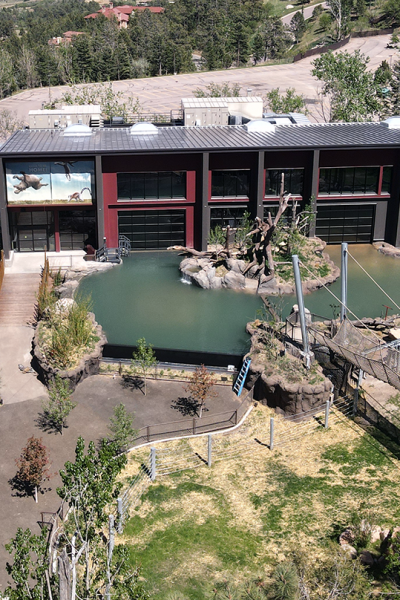

Saturday, May 23, 2020 (COLORADO SPRINGS, Colo.) – With Water’s Edge: Africa Construction Issues Resolved, Nile Hippos Return to CMZoo! The sounds of hippo ‘laughs’ are once again echoing from the side of Cheyenne Mountain. Zambezi (zam-BEE-zee) and Kasai (kuh-SIGH), CMZoo’s Nile hippo sisters, are back home at Cheyenne Mountain Zoo!

The two female hippos have been ‘vacationing’ at Dickerson Park Zoo, an Association of Zoos and Aquariums-accredited zoo in Springfield, Missouri, since October 2016, when construction began on Water’s Edge: Africa. Zambezi, 27, originally came to Cheyenne Mountain Zoo in 1993. Kasai, 20, originally came to CMZoo in 2001. Given their long-time residence and personable demeanors, the girls are well-loved by staff, the community and CMZoo fans all around the world.
“The question of the year has definitely been, ‘When are the hippos coming back?’ We’re just so happy the girls are finally home,” said Patty Wallace, senior lead keeper at Water’s Edge: Africa, the new home for hippos, penguins, warthogs, lemurs and more, at CMZoo. “There were a lot of happy human tears and a lot of wiggling hippo ears on Friday morning, as we watched them explore their new home. It’s so fulfilling to see them enjoying this beautiful space and settling back in. We missed them!”
The hippos’ 750-mile journey home wasn’t your average road trip. Preparing to transport the girls, who each weigh over 3,000 pounds, required months of preparation, skilled staff and transport professionals, and specialized machinery and equipment. Three CMZoo staff members drove to Dickerson Park Zoo to help the hippos transition and bring them home. The team consisted of Wallace; Jeremy Dillon, Water’s Edge: Africa Animal Care Manager; and Dr. Liza Dadone, a veterinarian and the Zoo’s Vice President of Mission and Programs.
“This isn’t their first road trip, but it’s been three and a half years since their last transport, so we don’t make any assumptions about how smoothly things will go,” said Dillon. “Transporting nearly four tons of hippopotamus is risky, no matter how many times you’ve done it. Since they arrived at Dickerson Park Zoo, back in 2016, they’ve been preparing for this trip home – and so have we.”
Making sure Zambezi and Kasai are comfortable and confident during their transport is vital to keeping them from getting too stressed or injuring themselves. The hippos are trained to be comfortable in their crates during a transport, which means they are awake for the entire transfer.

The steel-framed wooden crates were positioned as ‘hallways’ at Dickerson Park Zoo, so the hippos would pass through them daily when they went out into their yard. That meant they became familiar with the space and gained confidence being inside the crates. Through positive reinforcement, the girls became comfortable standing in the crate with only one end open, and eventually standing in their crates with both doors closed.
Thursday afternoon, the girls entered their separate crates, which were crane lifted out of their exhibit space and then lifted by forklift into a climate-controlled 72-foot semi-truck. After 12 hours of highway driving, with stops to check on the girls every two hours, the team arrived at Cheyenne Mountain Zoo around 5 a.m. Friday, May 22. From the Zoo’s public parking lot, the hippos were lifted one at a time, in their crates, by forklift and carried up to their new home.
“The transport really couldn’t have gone any better,” said Dillon. “Watching them come out of their crates, healthy and curious to explore their new home was awesome. I just wish we could share this experience with the public right away.”
Under current restrictions, the Zoo is temporarily closed to the public until further notice. But, when the Zoo is allowed to reopen, guests will be able to see the girls from one-of-a-kind perspectives, like the Water’s Edge: Africa giant rope bridge that hangs 8 feet above the outdoor hippo yard.

“I can’t wait for people to come and see Water’s Edge,” said Grace Vining, animal keeper. “It’s like an educational nature playground for animal lovers.”
Nature play was central to the design of Water’s Edge: Africa, so it features a nature trail with obstacles, like vertical logs to climb on and small boulders to hop, that leads to a huge rope bridge and ends at a platform overlooking the outdoor hippo pools and lemur island.
Cheyenne Mountain Zoo is known for providing interactive experiences with animals, and guests can expect that same level of engagement with animals at Water’s Edge: Africa. As many barriers between guests and animals have been removed as possible. A knife-edge hippo pool brings guests eye-to-eye with the hippos, as they bounce on a sand bar in their outdoor pool. Hippo lovers might even feel a splash or two, as the hippos make waves that flow over the exhibit’s many waterfalls. Guests are likely to leave the exhibit with wet feet, too, thanks to an ‘ocean surge’ from the outdoor penguin pool that splashes onto guest viewing areas. That surge isn’t the only thing guests will want to look down for – the outdoor penguin area is designed so penguins have the opportunity to walk right up to guests if they want to.
Eleven African penguins arrived at Water’s Edge: Africa at the end of April. Nine more will be joining the flock as soon as possible. In addition to African penguins and Nile hippos, ring-tailed lemurs and common warthogs will make homes at the brand-new exhibit, as well as a few other species.
Only 30 organizations accredited by the Association of Zoos and Aquariums in North America house hippos. The International Union for Conservation of Nature (IUCN) Red List categorizes Nile hippopotamuses as a species vulnerable to extinction in the wild, estimating 125,000 to 150,000 remain in their native habitats. The primary threats are habitat loss and illegal and unregulated hunting. Hippos are hunted for ivory, which is found in hippopotamuses’ canine teeth, and for food.
About Cheyenne Mountain Zoo
Cheyenne Mountain Zoological Society was founded in 1926. Today, Cheyenne Mountain Zoo, America’s mountain Zoo, offers comprehensive education programs, exciting conservation efforts and truly fantastic animal experiences. In 2019, Cheyenne Mountain Zoo was voted #6 Best Zoo in North America and CMZoo’s Rocky Mountain Wild was named #5 Best Zoo Exhibit in North America by USA TODAY 10Best Readers’ Choice Awards. It is Cheyenne Mountain Zoo’s goal to help guests fall in love with animals and nature, and take action to protect them. Of the 233 zoos and aquariums accredited by the Association of Zoos and Aquariums (AZA), Cheyenne Mountain Zoo is one of just a few operating without tax support. Cheyenne Mountain Zoo depends on admissions, membership dues, special event attendance and donations for funding.
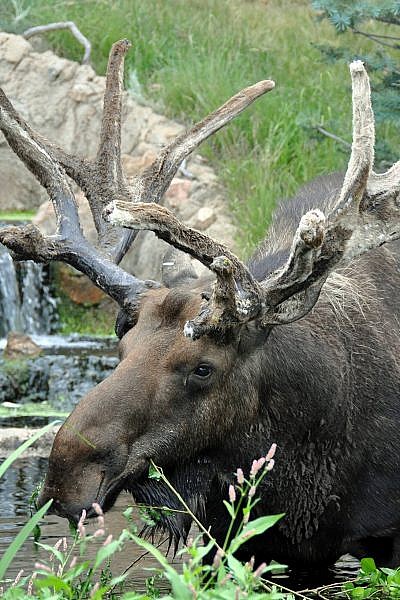

This weekend, the Cheyenne Mountain Zoo family said a difficult goodbye to Tahoma, our well-loved friend and colleague in the fight to save wildlife.
“We strongly believe all of our animals have a very important job to do,” said Bob Chastain, president and CEO of Cheyenne Mountain Zoo. “They are ambassadors for their wild counterparts. They do the yeoman’s work of inspiring millions of people to understand and care about the challenges wild animals face.”

We humans are the best chance animals have for thriving in the wild. Tahoma helped tell the stories that inspired people to help. He encouraged people to do things like buying a hunting or fishing license, paying state park entrance fees, reducing mining by recycling, saving water and contributing to conservation efforts. Every visit to the Zoo is conservation in action. Tahoma’s CMZoo fans raise money and vote for conservation projects around the world through a portion of their memberships and entrance fees.
“Like many of our animal teammates at the Zoo, even him being here was a bit of a miracle that the people of Colorado Springs might not know,” said Chastain. “While you might get lucky and see moose in the wilds of Colorado, seeing how amazing they are up close in a safe environment is a rare treat.”
Cheyenne Mountain Zoo was one of only eight AZA-accredited institutions in the United States to house moose. Because moose are so rare in human care, there was little studied or known about their care and management until recently. Tahoma partnered with his care team to pioneer moose care practices, like formulating nutritious moose diets, blood tests, hoof care and more.
For people who haven’t worked at a place like Cheyenne Mountain Zoo, it may seem odd to refer to a moose as a colleague. But CMZoo staff firmly believe that all of us – humans and animals alike – have one main job to do, which is to connect guests with animals, and inspire them to care about wildlife. Tahoma did that job better than most of us.

Tahoma came to Cheyenne Mountain Zoo as a 10-month-old calf, and immediately began making connections with guests in the newly opened Rocky Mountain Wild exhibit. Less than two weeks shy of his 13th birthday, due to chronic arthritis pain and other conditions that could no longer be controlled with medication and treatments, Tahoma’s care team made the difficult decision to humanely euthanize him. He passed peacefully on a soft bed of cedar shavings, surrounded by his loving keepers and vet staff. Tahoma spent nearly his entire life inspiring guests and staff at Cheyenne Mountain Zoo, and he will be remembered forever by those whose hearts he touched.
“All of our animals make an impact in their own way, but Tahoma took it above and beyond,” said Rebecca Zwicker, animal care manager in Rocky Mountain Wild, who worked with Tahoma for 10 years. “Before Tahoma, I never would have considered myself a ‘moose person,’ but he had me within the first minute of meeting him. I looked into those big brown eyes and handed him a cracker, and he nuzzled my hand and immediately had my heart. I can’t really put it into words, but there was something magic about Tahoma, and I know I’m not the only person who felt that.”
Zwicker and the rest of the Rocky Mountain Wild care team believe in the Zoo’s philosophy that our animals are our respected colleagues, and that we complete the work of the Zoo together as a team. We believe our animals are the essence of the Zoo. Our role is to help them succeed at their jobs, by providing the best possible habitats, health care, training, and opportunities for them to create meaningful relationships with our guests.
“Tahoma had this special way of connecting with people,” said Basia Dann, Rocky Mountain Wild animal keeper. “It was like he knew when we were busy and he needed to ‘work’ a little harder to reach more people. We would find huge crowds of people admiring him on busy days. He would position himself really close to people and create those opportunities for us to answer questions about moose and teach people about him to foster those important connections. That’s our job, and he was really good at it.”

Tahoma was a quick study. Through positive reinforcement training, Tahoma and his keepers built a relationship that meant everyone could look forward to training sessions. It didn’t take him and his keepers long – sometimes just one day – to perfect voluntary injection training, ear cleaning sessions, x-rays, laser therapy, EKG readings and blood draws. Tahoma was a catalyst for Cheyenne Mountain Zoo’s renowned hoof care program. He was one of the first animals at the Zoo to voluntarily receive care on his hooves.
“I know for a fact what we learned from Tahoma has helped our giraffe,” said Zwicker. “There are other zoos in the U.S. that have started working with their moose because of the work we did with Tahoma. He was inspiring.”
Zwicker recalls sharing Tahoma’s achievements in hoof care to a room of three hundred people at an animal husbandry behaviors conference. That conference and another, during which zookeepers and trainers spent a day at Cheyenne Mountain Zoo and met Tahoma, led to somewhat of a celebrity status for him in the zoo community. Tahoma was photographed for National Geographic photographer Joel Satore’s ‘The Photo Ark’ series and was even featured in a popular outdoor clothing company’s advertising campaign.

“He’s a legend,” said Sarah Dugger, Rocky Mountain Wild animal keeper. “I’ve been tracked down by keepers when I’m visiting other zoos just because I was Tahoma’s keeper. Even if they had never met him, they knew about Tahoma and had been inspired by him in some way. It wasn’t about meeting me; it was exciting for them to meet someone who worked with Tahoma.”
Tahoma made an enormous impact, and will leave a personal mark on so many lives. Thousands of people looked forward to guessing the weight of his antlers in Tahoma’s Annual Antler Weigh-In. He was motivation for a woman who had breast cancer and met her goal of visiting him once she went into remission. His face is tattooed on people’s bodies. He touched people’s hearts and expanded people’s horizons through education and the reminder that it’s always worth it to work to achieve a goal.

Although the Zoo was closed to the public on Tahoma’s last days, he was visited by his colleagues from every department at the Zoo.
“We showered him with love on his last few days,” said Zwicker. “It’s always a difficult decision, but we loved him too much to let the pain last. I’ve been thinking of our guests and how much they’re going to miss him, but want them all to know that he didn’t go out without any fanfare.”
Tahoma’s legacy will continue through the work of his fellow animal ambassadors, keepers, Cheyenne Mountain Zoo staff, the greater zoo and conservation communities, and the people who take action to protect wildlife and wild places because of the deep connections he made.
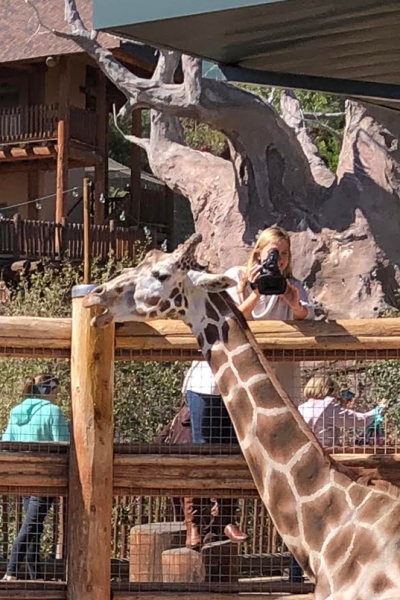

The Cheyenne Mountain Zoo family is celebrating the long life of the eldest member of the Zoo’s reticulated giraffe herd, Riyadh, today. Since her birth at CMZoo in 1990, she made countless connections with guests, members and fans, who would delight at her small-but-mighty personality and regal nature.

As she grew older, Riyadh began showing normal signs of aging, including dealing with arthritis. Over the last several months, she responded well to medications and seemed to be comfortable. But yesterday, her keepers noticed she wasn’t bearing weight on her hind right leg. With the CMZoo vet team, they made the difficult decision to humanely euthanize Riyadh, as her treatments were no longer providing enough relief for her to continue having a comfortable quality of life.
“Despite the fact that we’ve been mentally preparing for this time to come, it’s still sad to say goodbye,” said Rachael Hahn, animal keeper for giraffe and Riyadh’s primary trainer. “This was the right decision for her, and I’m so glad she was able to spend her last day in the beautiful Colorado sunshine.”
Riyadh was loved for her small stature and confident personality. She was much shorter than the majority of the herd, and was often mistaken for a calf.
“People really fell in love with her because she was easy to tell apart from the rest of the herd,” said Amy Schilz, senior lead keeper for giraffe. “Those who didn’t know her sometimes thought she was a baby, and she would benefit by getting extra lettuce from guests who wanted to feed ‘the little one.'”
“She was also one of our giraffe that was more willing to let guests give her scratches on her neck, which was a special experience that not every giraffe will allow,” said Diana Miller, senior animal keeper for giraffe. “For some reason, she was hesitant to let keepers touch her neck, but she didn’t mind at all when guests would pet her.”
Her shorter legs made her easy to identify in the herd, but didn’t impact her confidence if she was ever nudged by a larger herd mate.
“She was hilarious to watch interact with the other giraffe because of how tenacious she was,” said Hahn. “She could get whatever she wanted, despite her size. Most of our giraffe get out of the way when Mahali, who’s one of our tallest giraffe, comes around. But not Riyadh! She would push him around to get the best browse or whatever she wanted. All of the other giraffe got out of the way for Riyadh.”
The keepers describe Riyadh as having a “regal” way about her – so much that they had nicknamed her “Princess Ri.”
Riyadh helped the newest herd member, 2-year-old Panya, settle in to the herd, spending nights with Panya in a stall separate from the herd while Panya, who has a shy demeanor, adjusted to her new surroundings.
“Panya and Riyadh developed a strong bond,” said Miller. “It seemed like they found a soulmate in each other, since they’re both smaller in stature.”
Riyadh, pictured here in Sept. 2019 sharing the side yard with Viv, was known for her small stature and unique markings
Throughout her life at CMZoo, Riyadh contributed to her species as a well-loved animal ambassador and through her individual reproductive contributions. Riyadh gave birth to eight healthy calves, leaving a legacy of six healthy grandcalves and one healthy great-grandcalf. Two of Riyadh’s daughters, 19-year-old female giraffe, Twiga, and 22-year-old female, Muziki, are still members of the herd at CMZoo.
Riyadh participated in voluntary training that allowed our vets and staff to help giraffe in human care and in the wild. All giraffe in our herd can choose to participate in trainings that allow vet staff to perform research on hoof care and even build a life-saving plasma bank.
“Riyadh was a little difficult to train in the beginning,” said Schilz. “She would outsmart me on every maneuver! Once we figured out a way to give her full control over everything that was happening, we started to make headway. She learned to touch a target stick, which was our cue that we could touch her hooves or do some other contact that we needed. If she gave us ‘permission’ by using the target stick, we were good. But she could still throw out a stern ‘side-eye’ look, if she didn’t approve of something we were doing.”
Once Riyadh and her keepers figured out the key for her training, she became a training superstar. She was often the giraffe that helped teach other giraffe professionals from around the world how to train during CMZoo’s annual Giraffe Care Workshop. Since she was smaller, she was less intimidating for participants to work with, and she was solid in responding to cues, even for those who didn’t have a relationship with her or have as much experience with training giraffe.
“Even as her primary trainer, she taught me so much about training and caring for giraffe,” said Hahn. “She was just so smart! She was super special.”
She also helped to pioneer groundbreaking care for our herd, as she was one of the first to voluntarily accept shoes on her hooves as a treatment for her arthritis. She also voluntarily allowed a veterinary ophthalmologist to take her eye pressure readings using a puff of air (non-contact tonometry) – something many humans have trouble tolerating.
In the past 30 years, there has been an estimated 50 percent decline in wild reticulated giraffe populations. Giraffe Conservation Foundation estimates only 15,780 reticulated giraffe remain in the wild.
Riyadh’s role as an ambassador for her species helped countless CMZoo guests fall in love with giraffe, inspiring them to take action to protect her wild relatives. CMZoo has partnered with the Giraffe Conservation Foundation to support conservation efforts. One recent example is Operation Twiga, a giraffe translocation project in Uganda, Africa. The Zoo’s visitors and members contribute significantly to those efforts through Quarters for Conservation, a program by which 75¢ of every Zoo admission is allocated to conservation. Annually, Quarters for Conservation raises half a million dollars for conservation partners around the world.
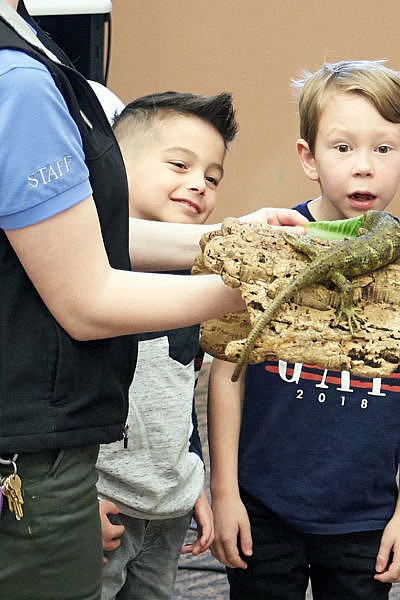

These are certainly abnormal times, but we’re forging ahead as normally as possible — and that means it’s time to start planning Summer Zoo Camp! Although the future is a little unclear, our goal is to operate summer camp as we do every year, with lots of fun animal experiences for campers from kindergarten through ninth grade! Cheyenne Mountain Zoo will pay close attention to this ever-changing situation and adjust camp programs as needed to adhere to any guidelines in place during camp season.
Summer Zoo Camps have been very popular in past years and registrations are limited, so plan for the best-case scenario and register now at cmzoo.org/summercamp.
We’re excited to share some of the new offerings for Summer Zoo Camp 2020! Here is just a sample of some of the camps to look forward to:

Kindergarten Camps include a Sensory Safari, Animal Who’s Who, and a fun new camp focusing on animal movements. Animal Movin’ and Groovin’ gets campers up and moving like a peacock shaking its tail feathers! It’s time to groove your way through the Zoo and explore the wonderful world of animal locomotion! (New this year: Full-day and half-day camps are available for our Kinder-campers!)
First- and Second-Grade Camps feature themes like Wild by Design, Home Sweet Habitat, and an imaginary international expedition, called Global Safari. Our planet is home to an abundance of diverse landscapes, remarkable cultures, and incredible animals. It’s a WILD world out there! Travel around the Zoo with us as we explore our animals and uncover the wondrous worlds their wild counterparts call home.
Third- and Fourth-Grade Camps focus on animal fun facts, animals’ unique abilities and some gross-but-normal things in the animal world. Your camper can choose from Creature Kitchen, Animal Champions or Grossology for their summer camp adventure.
Fifth- and Sixth-Grade Camps involve animal detective work! New this year is Furensic Files, where we work in conjunction with U.S. Fish and Wildlife Service and the National Wildlife Property Repository. Campers will use their sleuthing skills to solve a pretend wildlife trafficking case.
All of these options (plus a few more for each age group), more information and registration are available at cmzoo.org/summercamp. Be sure to sign your camper up for the grade they are entering in the fall.
We can’t wait to see you at Summer Zoo Camp!
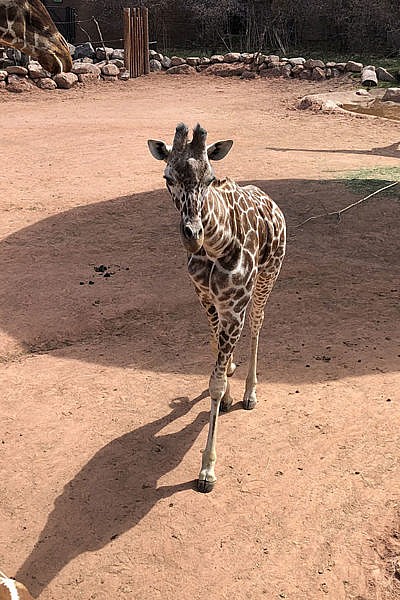

Children’s Hospital Colorado, our year-round sponsor, offers helpful guidance for helping children cope with stress and anxiety related to the ‘new normal’ of life during the coronavirus pandemic. In addition to a recent blog, they will be hosting a virtual talk on the topic, just for members and fans of Cheyenne Mountain Zoo, on Friday, May 8. (See all the details on the talk at the end of this article.)
Similarly, Cheyenne Mountain Zoo’s animal care department has found ways to help the animals in their care stay engaged and healthy, despite the changes in their daily lives.

“We’re working to help them feel as little interruption to their normal routines as possible,” said Jeff Halter, vice president of animal care. “Our animals are participating in training, husbandry behaviors, enrichment activities and daily interactions with their keepers. Through our Abnormally Normal series on social media, they’re participating in keeper talks and demonstrations. But, we can tell they know there’s something important missing from their normal lives: our guests and members.”
In May 2019, more than 80,000 people visited Cheyenne Mountain Zoo. Going from an average of 2,500 visitors per day to none has been an adjustment for everyone – including most of the animals. We told you last month about how the great apes of Primate World have shown us they miss guests, and they’re not the only ones.
The African elephants have noticed a difference in their routines, too. The elephant herd of six females usually stays in groups of two or sometimes three in various areas of the yard and barn. One of those groups is Missy and LouLou.
“When we first closed, the elephants were used to their regularly scheduled feeding experience with guests, which always takes place right after the elephant demonstration,” said Stacey Smith, elephant and rhino keeper in Encounter Africa. “LouLou would see Missy going to the demo yard, so LouLou would head over to the elephant ‘snack time’ area in anticipation of her time with guests. After completing Missy’s training, we keepers would call for LouLou for her time to train in the demo yard. This only happened a few times, but LouLou would hesitate at the ‘snack time’ area, seemingly disappointed that there wasn’t a line of guests waiting to give her attention and treats.”
Keepers have been getting creative with ways to keep the animals in their care mentally and physically enriched. To replace keeper talks, giraffe keepers say they’re doing more frequent training and providing more enrichment items. The elephants are continuing daily training and foot care in the demonstration yards, and recently enjoyed a whole watermelon each for Easter. Last week, the elephants got special tree trunks and a mud wallow, which they thoroughly enjoyed in a light spring rain.
“Since we’ve been closed almost six weeks now, they’re getting more used to this new routine and not having those 30-minute snack times with guests,” said Smith. “We don’t offer those snack time experiences in the winter, either, so it’s not entirely new for the elephants. We’ve been providing extra enrichment and training so they’re staying engaged, but I’m sure they’ll be excited to get that time back with people once we reopen.”
However, not all animals seem to notice a lack of guest interactions in their daily lives. Keepers say the CMZoo pack of seven Mexican wolves, for example, isn’t experiencing much out of the ordinary. The wolf pack, unlike most animals at CMZoo, doesn’t participate in training or interact with guests. The wolf exhibit is expansive and the guest viewing area has one-way glass, so the wolves don’t see as much of our guests than most other animals. They are intentionally kept as wild as possible because the hope is that their future offspring could be released to supplement the endangered species in the wild.
Most members of CMZoo’s reticulated giraffe herd of 16 seem to miss guests and get particularly interested in the staff who visit them – with or without lettuce. The giraffe boardwalk in African Rift Valley puts giraffe and guests face-to-face during daily lettuce feeding opportunities, so most of the giraffe are used to interacting with large numbers of people.
One member of the CMZoo giraffe herd may be benefitting from the quiet time, though. Panya, a 2-year-old reticulated giraffe who joined the CMZoo herd in September, recently started spending time with the full herd after slowly meeting various members over the winter.
“Panya has been shyer than a lot of our herd members,” said Kayla Ringuette, African Rift Valley keeper who works closely with Panya. “Because of the closure, we’ve been able to help Panya gain confidence in the big yard more quickly than we might have been able to with guests, because she has been pretty hesitant in the past.”
Panya began her introductions to the herd in the barn, over the winter. She started going outside in mid-April with some of the herd and later in the month with the whole herd.
“While the majority of our herd definitely misses guests, this time has allowed Panya to get really comfortable with the yard and the herd, which could have been intimidating for her with large numbers of people,” Ringuette said. “When we reopen she’ll be confident in the yard with the herd, and she’ll be ready to meet our awesome herd fans. If there is a silver lining, it’s that Panya got this extra time she’s using to adjust. She’s doing so well.”
Animals can be an inspiration during difficult times, showing us how they adapt to changes and show resilience through challenges. We’re working to continue fostering connections between our members and guests and the animals they love.
The Zoo is embracing its role as a community resource, even while we can’t invite our community inside our gates. Through online activity videos, keeper talks, animal demonstrations and moments of #CMZooZen, our team continues to reach our fans and inspire a love for animals and the natural world. CMZoo’s social media platforms are buzzing with our timely series called Abnormally Normal.
Although we’re temporarily closed, we’re permanently committed to caring for our animals and keeping you connected to our mission, our animals and the natural world. It’s definitely an abnormal time in the world, but we’re providing special glimpses at how normal things are at the Zoo. Follow our Abnormally Normal Video Series on Facebook and YouTube! As always, our guests are enjoying the giraffe herd remotely, using our two live streaming Giraffe Cams overlooking the outdoor yard.
In effort to serve as a continued resource for children and families during these uncertain times, Children’s Hospital Colorado is hosting a live webinar on Friday, May 8 at 12 p.m. MT. Dr. Jessica Hawks, clinical child and adolescent psychologist at Children’s Hospital Colorado, will be presenting on the topic of COVID-19 and Mental Health. Dr. Hawks will describe unique challenges children, teens and parents are facing during the COVID-19 crisis, how parents can talk to their kids about COVID-19, warning signs that a child or teen may be experiencing mental health concerns, and how children, teens and parents can best cope during this difficult time. Time will be reserved for Q&A to address any specific questions families may have regarding this topic. Click this link on Friday, May 8, 2020 at 12 p.m. to join the live webinar on Zoom, hosted by Children’s Hospital Colorado: https://ucdenver.zoom.us/j/95899621728.